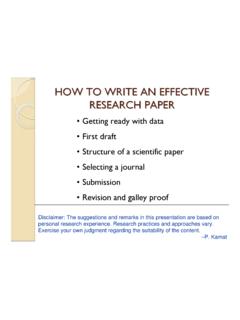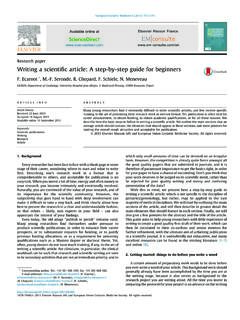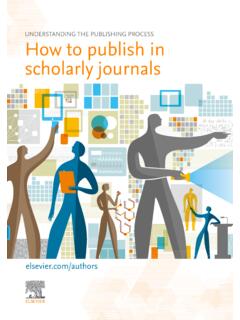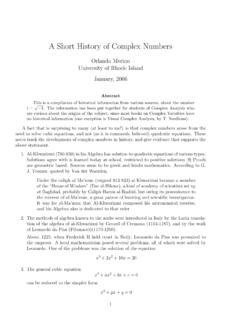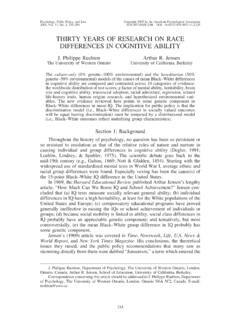Transcription of A Step by Step Guide to Writing a Scientific Manuscript
1 A Step by Step Guide to Writing a Scientific Manuscript Volker Wenzel, , , Martin W. D nser, *, Karl H. Lindner, Department of Anesthesiology and Critical Care Medicine, Innsbruck Medical University, Innsbruck, Austria; (*current affiliation: Department of Intensive Care Medicine, University of Bern, Switzerland) Abstract About 50% of abstracts presented at conferences get published as full manuscripts . This Manuscript is a hands-on instruction on how to publish a Scientific investigation. Criteria for authorship should be based on the International Committee of Medical Journal Editors Uniform Requirements for manuscripts Submitted to Biomedical Journals: Writing and Editing for Biomedical Publication.
2 The first step is always to read the Guide for Authors of the journal where you intend to submit the Manuscript . Start the Manuscript preparation by describing the materials and methods, including the planned statistical analysis (~1,000 words or less). This can often be copied from the study protocol. The second step is to describe the results (~350 words). The methods and results are the most important parts of the paper. When possible, use figures rather than tables to show your results. The discussion typically starts with a short overview of the most important results, followed by an assessment why the chosen design or model is appropriate. The discussion should place the results into contact, and present the clinical impact of the findings.
3 The discussion should also acknowledge limitations of the study. The final conclusions should be low-key rather than exaggerated. The last step is Writing the introduction (~350 words), the abstract, and the title page. Generic mistakes include failure to state a hypothesis, not answering the hypothesis, contradictions within the Manuscript , superficial or rambling discussion, inconsistent use of terms, and a conclusion that is not supported by the data. In conclusion, Writing Scientific manuscripts need not be difficult or painful. With a little bit of organization, discipline, and persistence, Writing manuscripts can be learned rapidly, thus producing excellent exchange of experience, personal success, and Scientific progress.
4 Nothing looks as simple as an implemented idea. Wernher von Braun, Engineer of the United States NASA Apollo Space Program 1 Introduction Medical science consists to a large degree of discussion and exchange of experience and observations. These may occur via direct dialog among scientists, presentations at conferences, and by means of Scientific manuscripts in peer-reviewed journals. Only 50% of abstracts presented at Scientific meetings are published in peer-reviewed This is surprising, given that publication of manuscripts is used as a measure of academic success by investigators, their colleagues, their department chair, and those who fund their studies.
5 This Manuscript is intended to provide step by step instruction on how to write a Scientific Manuscript . The purpose is to provide a cure for writer's block, and thus enhance a successful Scientific The audience for this Manuscript is the junior academician who needs guidance on how to write a Manuscript . There are many ways of tackling manuscripts , and this approach is merely one straightforward method. Although the envisioned Manuscript is the research report, these same principles apply, mutatis mutandis, to review articles, brief reports, editorials, and case Step 1: Read the Guide for Authors Most journals have a Guide for Authors that is printed at least once yearly and is available online. Anesthesia & Analgesia offers an unusually comprehensive Guide for Authors, which appears yearly as a Special Article4 as well as being available Prior to preparing your Manuscript , download and carefully read the Guide for Authors of the journal where you intend to submit your Manuscript .
6 There will be detailed information about the interest and scope of the journal, specific information about Manuscript types, and detailed instructions on formatting your Manuscript . Editors and reviewers notice when authors have not even bothered to read the Guide for Authors or flagrantly disregard 1 , last accessed August 4, 2009 instructions on Manuscript preparation, style, and formatting. Anesthesia & Analgesia also recommends that authors read The Elements of Style by W. Strunk and This is a modest and inexpensive text that can be read in a few hours. It describes a very clear and succinct Writing style that is appropriate for Scientific publications. Step 2: write the Materials and Methods The Materials and Methods section is the most critical part of the Manuscript .
7 It should describe what, exactly, you did in the study. Typically there is a handy document that already describes the materials and methods: the study protocol. Therefore, an easy and logical place to start is to cut and paste the study protocol into your Materials and Methods section. The Materials and Methods section should typically consist of fewer than 1,000 words. A simple laboratory study might be shorter than this, while a protocol that introduces new methodology may require a very extensive explanation. The materials and methods should describe the study in sufficient detail so that a skilled investigator in the field could replicate the study. If the study uses previously published methodology, appropriate reference should be supplied.
8 Often the material and methods will use methodology that has been previously used by the laboratory, for example a particular assay or experimental model. In this case, it is acceptable to adapt verbatim previously published material by the same If your study involves human subjects, always start with a statement about Institutional Review Board approval and informed consent. If your study involves animal subjects, always start with a statement about approval from the appropriate review board. Following these, describe your study population in explicit 2 Of course, it is never acceptable to copy text by another author without appropriate reference and the use of quotation marks if the text is copied verbatim.
9 2 detail. Typically this can be found in the study protocol. If the population is divided into multiple groups, these should be defined. It is easier to read a study if treatment groups are given clear names ( , the propofol group vs. the etomidate group) than simply given letters (group A vs. group B). If there is a random assignment of treatments, the randomization process should be defined. After defining treatment groups, describe how the study was conducted in each group. Typically the description follows a temporal sequence, describing each step in order. Be certain to include all of the measurements that will be reported in the results. Any measurements that were taken to ensure the safety of subjects should also be reported.
10 After describing the treatments, describe the data analysis plan. This includes how the data were analyzed, including the statistical treatment of the data. Consult a statistician to make certain that the statistical analysis is appropriate, and that it is accurately described in the Manuscript (Tables 2, 3). Start with a description of the power analysis that was performed (if any). That should be followed by a description of the statistical analysis of the primary endpoint, followed by a description of how secondary endpoints (if any) were analyzed. Complex or unusual analysis approaches should be explained in sufficient detail to permit a skilled statistician to reproduce your results from your data. Avoid non-standard abbreviations.



